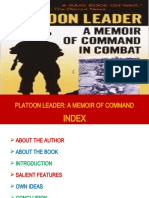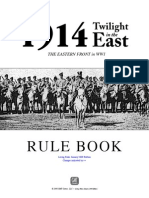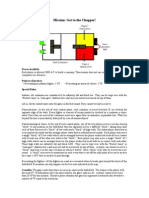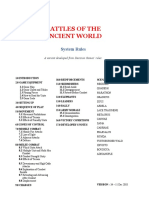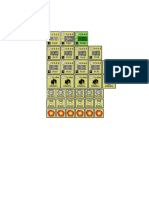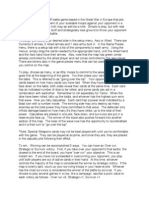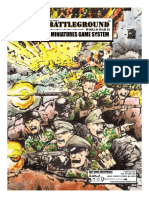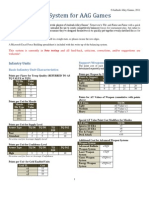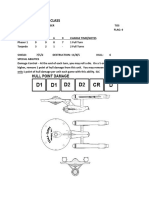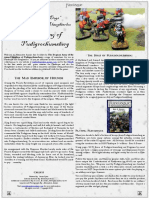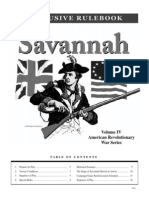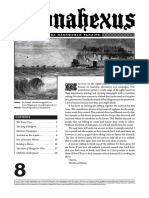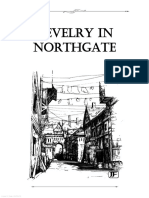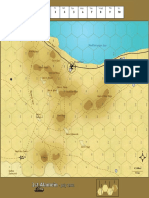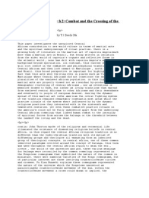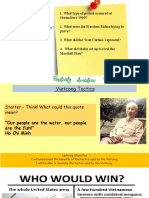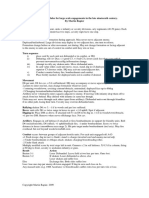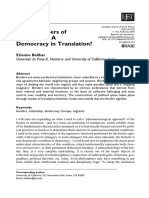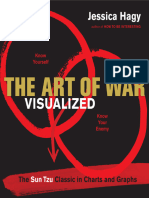Battle For Moscow Expansion-Rules
Battle For Moscow Expansion-Rules
Uploaded by
senhor_xCopyright:
Available Formats
Battle For Moscow Expansion-Rules
Battle For Moscow Expansion-Rules
Uploaded by
senhor_xCopyright
Available Formats
Share this document
Did you find this document useful?
Is this content inappropriate?
Copyright:
Available Formats
Battle For Moscow Expansion-Rules
Battle For Moscow Expansion-Rules
Uploaded by
senhor_xCopyright:
Available Formats
Battle for Moscow Expansion Kit: Winter Counteroffensive Game Rules v1.
0 1
● 1 Player Aid set up map and game notes 8. Russian (Special) Rail Movement Phase.
Battle for ● 1 Rules booklet All Russian Mechanized Cavalry and
Moscow [3.2] Game Charts & Tables: The left side
of the Expansion Kit Player Aid mat is placed
Reserve units (only) can move again
(including those that moved in Phase 6).
Expansion on top of the right side of the Battle for Administrative
Moscow mat such that the Expansion Kit
Kit: Game Turn Track completely blocks out the
9. Housekeeping Phase.
A. Stavka Segment: The Russian Player
Winter Counteroffensive Basic Game’s Turn Track.
check the Stavka HQ unit’s LOC and
[3.3] The Playing Pieces: The following new decides whether to change its posture.
Table of Contents unit types are included:
B. Game Turn Marker Segment:
[1.0] INTRODUCTION............................ 1 Unit Type Symbols Advance the Game Turn marker or, if the
[3.0] GAME EQUIPMENT ...................... 1
last turn was played, stop and determine
[4.0] SEQUENCE OF PLAY..................... 1 the winner.
[5.0] HOW TO WIN ............................... 1 C. Variable Weather Segment: If the
[6.0] SETTING UP THE GAME ............... 1 Airborne Mechanized Stavka
Game Turn marker was just advanced
[8.0] MOVEMENT ................................. 2 Cavalry
into a variable weather turn, the German
[9.0] COMBAT ...................................... 3 Unlike all other combat units in the game player rolls a die to determine that turn’s
[10.0] REPLACEMENTS ........................ 3 which have two sides, the Russian airborne weather.
[11.0] REINFORCEMENTS..................... 3 corps has only a single full-strength (front)
[12.0] WEATHER .................................. 3 side; the back of these units is blank, denoting [5.0] HOW TO WIN
the fact that these units have no reduced- Victory is determined primarily through the
[16.0] STAVKA HEADQUARTERS .......... 3
strength (back). control of cities, regardless of their “in com-
[17.0] AIRBORNE OPERATIONS ............ 4
The Russian Stavka unit is a special munication” status (see Rule 10.0).
[18.0] STALIN ....................................... 4
headquarters with no Combat Strength. [5.1] The Winter Counteroffensive scenario
[0.0] USING THESE RULES [4.0] SEQUENCE OF PLAY (see 6.0) is won as follows:
The Battle for Moscow Expansion Kit The Russian Player wins if he controls
Game Length: There are fourteen Game
integrates with the Basic Game Rules Moscow and six or more Victory Points
Turns in the expanded Battle for Moscow (VPs). The Russians gain one VP for every
numbering system and supplementing those
rules. If there is a conflict between the two game. Alternately, players may choose to play other (besides Moscow) Russian controlled
rules sets, the Expansion Kit rules take an abbreviated game of just the last seven city on the map and destroyed (not merely
precedence. Game Turns (Turns 8-14) covering only the reduced) Panzer corps at the game’s end.
Russian Winter Counteroffensive.
The German Player wins if he controls
[1.0] INTRODUCTION How the New Sequence of Play Works: The Moscow and it is “in Communication” (see
In a desperate attempt to capture Moscow by first four Phases of each turn (i.e., the German
10.0) -OR- if, at the end of the game, the
the end of 1941, the Germans launched a final Player Turn and the Russian Replacement
Germans score at least six VPs. The
attack on the city called Operation Typhoon. Phase of the Russian Player Turn) are
Germans gain one VP for every German
When their offensive finally ground to a halt unchanged.
controlled city on the map (including
just short of their goal, the Germans assumed The next three Phases can differ depending on Moscow, not in Communication) and lose
the Soviets had similarly run out of reserves – the Russian’s posture, shown by which side one VP per destroyed (not merely reduced)
they were wrong. of the Stavka Headquarters unit, if in play, is Panzer corps at the game’s end.
The Soviet counteroffensive initially up (either Attack or Build Up).
Any other result is a Draw.
succeeded in pushing the Germans back from While in Build Up posture, the
[5.2] The Campaign Game ends immediately
Moscow, liberating both Kalinin and Kaluga. Russian Player Turn’s Phases 6, 7
if either player achieves an Automatic
But when Hitler insisted on a “hold at all and 8 are unchanged (i.e., Special
“Decisive” Victory, defined as follows:
costs” strategy, the Russians were stopped by Movement, Combat, and then
a stubborn defense in front of Rzhev. Regular Movement). The German Player wins an
This expansion kit adds two new scenarios. Automatic Victory the
While in Attack posture, the two
The first is a Campaign Game extending the instant a German unit enters
Russian Movement Phases are
play to early March, 1942, when the Spring Moscow if the Stalin marker
reversed (i.e., Regular Movement,
thaw turned the countryside into a quagmire resides there (see 18.1).
Combat, and then Special Movement)
and brought the Soviet counteroffensive to a Also, two more activities are performed The Russian Player wins an Automatic
halt. The second scenario begins where during the Housekeeping Phase: the Russian Victory at the end of any Game Turn if his
Operation Typhoon ended and the Russians Army’s posture for the next turn and rolling forces control every city on the map -OR-
begin their own offensive. for next turn’s weather. at the end of Game Turn 11 if the German
Player has not placed the High Tide token.
[3.0] GAME EQUIPMENT Procedure
End Game Victory: If neither player
Parts Inventory Russian Player Turn (Attack posture) achieves an Automatic Victory, play
This expansion kit adds the following: 6. Russian Movement Phase. All Russian continues through Game Turn 14. The winner
● Eight 5/8” square pieces
units may move. is determined by comparing the Russian’s VP
7. Russian Combat Phase. All Russian units score to the box the High Tide token resides
● 1 plastic High Tide token
may attack. in on the Campaign Game Victory Meter.
● 1 Player Aid mat overlay/extension
© 2011 Lance McMillan, Frank Chadwick and Victory Point Games
Procedure Russian units left; these units are set aside, Stavka units causes it to be placed on the
At the end of the first German Player Turn available to be rebuilt via replacements. next turn of the Game Turn track to reenter
that a German unit either moves into/through 3. Then the German Player takes all his units play (see 16.3 and 16.5).
the Moscow hex or conducts an attack against and flips two 12-6, one 10-6, one 9-6, and [8.3] Zone of Control: A unit entering an
defending Russian forces in the Moscow hex, one 8-6 Panzer corps, along with one 8-4, Enemy Zone of Control must immediately end
the German player receives the plastic High one 7-4, and one 6-4 Infantry corps to its movement for that Movement Phase. There
Tide token. Once, at the end of any German their reduced-strength sides. He then places is no penalty or effect for leaving an enemy
Player Turn thereafter (including the turn it his units on the map in the hexes marked Zone of Control during a Movement Phase. A
was received), the German Player may place with a black cross on the map (see the unit can move directly from one EZOC to
the High Tide token on the Victory Meter in Player Aid sheet). At least another.
the space corresponding to the current number one unit must be placed in Exception: Russian Mechanized-Cavalry
of cities that are German controlled (including each indicated hex. Only units can ignore German Zones of
Moscow) as shown on its top-left half. Once reduced-strength units can be Control that extend into Forest or
placed, the German player cannot move this placed in the three hexes Swamp hexes and do not have to
token again. indicated by the flipped arrow symbols end their movement there due to EZOCs. That
The German Player must time the placement (i.e., hexes 1002, 1102, and 1206). is, they do not have to end their movement
of the High Tide Token carefully to achieve 4. The Stalin marker and the High Tide token when entering a Forest or if the German ZOC
the best possible score. are not used in this scenario. is exerted into a Forest or Swamp. This
The placement of the High Tide token 5. Play commences with the Turn 7 Russian “infiltration” only applies to movement, not
establishes the number of Victory Points Replacement Phase (i.e., mid-Game Turn). retreating during combat!
(VPs), as shown on the bottom-right half of The game then follows the Sequence of Special Movement
that same box on the Victory Meter, that the Play (as per Section 4.0) until Game Turn [8.4] “Road” Move-
Russian Player must exceed in order to win 14 is completed. ment: A unit moving
(or equal to tie) the game. VPs are scored at along a rail line (i.e.,
the end of the game (only) as follows: [8.0] MOVEMENT moving from one hex to
+1 VP per Russian controlled city (except for General Rule an adjacent hex connec-
Moscow, which scores +2 VPs) Units are moved during the Movement Phases ted by a rail line between
(i.e., Phases 2, 4, 6, and 8) of each Game their adjoining hexside)
-1 VP if Stalin has been evacuated to To benefit from a rail
Turn, but the Russian Movement Phases vary pays only one Movement
Kuibyshev (see 18.2) line, it must cross the
in their order based on the current mode of the Point (1 MP) to enter that hexside being moved
German Panzer Losses: After its placement Stavka unit (16.0). hex, regardless of the
on the Victory Meter, the Russian Player through
normal costs to enter it
moves the High Tide token down one box New Rule: Stacking
(see the Terrain Effects Chart).
whenever a German Panzer corps is destroyed [8.2] Stacking: When playing with this
(not just reduced) and removed from the map. Expansion Kit, more than one unit may In effect, it is using the rail line as a road
remain in a hex. through the rough terrain.
Even if later replaced, the High Tide token is
never adjusted back upward. [8.2.1] Stacking Limit: A maximum of [8.5] Special Movement Phase: Not every
two friendly units can be stacked together friendly unit can move during a player’s
[6.0] SETTING UP THE GAME in a hex at the end of each Phase or at the Special Movement Phase. Friendly Infantry
end of a Retreat (10.6). units in an EZOC cannot move during their
Procedure
Special Movement Phase.
A full Campaign Game sets up as Battle for Exception: No more than one Army-size
unit (either reduced- or full-strength) [8.5.1] Tank Units: German Panzer and
Moscow does, with play extending beyond
can be in a hex at the end of a Phase. Russian Mechanized-Cavalry units can
Game Turn 7 should the Germans not win
Thus, one Russian Army and one always move during both of their friendly
prior to then (see 5.0). Note that additional
Russian Corps, or two Russian Corps units Movement Phases and expend their entire
Russian Reinforcements are placed on the
can stack together. Alternately, two Axis Movement Allowance in each.
Game Turn track (see 11.0).
Corps units can stack together. [8.5.2] “Reserve” Infantry: A friendly
For the Winter Counteroffensive scenario, Infantry unit that does not start its Special
use the following: [8.2.2] Overstacking Penalty: At the end
of each Phase, units found in violation of Movement Phase in an EZOC is in reserve
Procedure and may move during that Movement
the above Stacking Limit are removed from
1. On the Game Turn Track, place the Game the map by their owning player. Phase, but it can only expend up to half of
Turn marker (on its Russian Player Turn its Movement Allowance at that time (but
[8.2.3] “Stack Free” Counters: Both the see Russian Rail Movement, below). It can
side) on Turn 7, and the remaining Russian
Stalin marker and Stavka Headquarters unit enter an EZOC normally.
Reinforcement units on their respective
Game Turns (see 11.0). may stack for “free” in any hex with other
Russian units or each other. [8.5.3] Russian Rail Movement: Russian
2. The Russian Player takes one full-strength Infantry units that begin their Special
Shock army, five full-strength [8.2.4] No Coexistence: A unit can never Movement Phase on a rail line hex and not
Infantry armies and five reduced- enter a hex containing an enemy combat in an EZOC can use “Rail Movement.”
strength Infantry armies. These unit. German units may enter hexes That is, they can expend their entire
are placed one per hex, among the containing only Russian stack free units. Movement Allowance (instead of just half,
)
hexes marked with a red star ( Entering Moscow while the Stalin unit is as above), but only if their entire Special
on the map (see the Player Aid there results in an immediate German Movement Phase movement is conducted
sheet). There should be six victory (see 5.0). Entering a hex with the along connected rail hexes. Note: Russian
Infantry units which use Rail Movement [9.4] Moscow Ablaze: After the High Tide [12.2] Mud: On Turns 3 and 4 (and possibly
can end their movement in an EZOC. token is placed, or during the Winter Turns 2 and 5), Mud conditions apply as
Soviet Rail / Reserve Movement Example: A Counteroffensive scenario, Moscow no follows:
Soviet Infantry Army begins the Soviet Special longer provides its one column odds reduction Movement in Mud: All movement in both
Movement Phase not in an EZOC and on a rail (1) to Germans units defending there. This the Regular and Special Movement Phases,
line. It could move up to four hexes along applies only to Moscow. except Russian Rail Movement, is reduced to
connected rail line hexes, or could spend two one hex per Phase.
Movement Points going in any direction.
[10.0] REPLACEMENTS
Combat in Mud: The Combat Strengths of
General Rule Panzer and Mechanized units are totaled and
[9.0] COMBAT If the Stavka unit is in Attack mode, then halved when attacking (only, not when
General Rule the Russians receive one fewer defending). Retain fractions when halving
The Combat Phase (Phases 3 and 7) remain replacement step that turn (see 16.2). There is (e.g., half of 9 is 4.5). The Strength of Infantry
essentially, with the following provisions: no effect on Russian replacements steps when units is unaffected.
the Stavka unit is in Build Up mode. [12.3] Snow: On Turns 9, 10 and 11 (and
[9.1] Stacking Effects on Combat: All units
in the defending hex must be attacked [11.0] REINFORCEMENTS possibly on Turns 8 and 12) Snow conditions
together; their Combat Strength is totaled. apply as follows:
The extended Russian reinforcements are as
Important: Only one unit may attack through Movement in Snow: It costs two (2)
indicated in the Setup Rule (6.0 #2), the Game
each hexside. That is, while more than one Movement Points to enter a clear terrain hex
Turn Track and on the units.
unit may occupy the same hex, only one can during snow; road movement [8.4] is not
attack across each hexside. Reinforcement Schedule possible during Snow conditions. Forest and
Game Turn 4: One Shock Army. Swamp hexes are unaffected.
Game Turn 7: Stavka Headquarters. Combat in Snow: Rivers are frozen and have
no combat effect.
Game Turn 8: One Shock Army, and Two
Mechanized-Cavalry Corps. Frostbite during Snow: At the end of Ger-
Game Turn 10: One Shock Army and One man Player Turn during snow, if the German
Airborne Corps. Player has conducted any attacks, he must
reduce one full-strength unit of his choice that
Game Turn 11: One Airborne Corps. participated in an attack. If all German units
Additional Reinforcement Locations participated in attacks are already at reduced
Reinforcements cannot create an over- strength, one must be eliminated. If the
stacking situation (see 8.2) when placed. German Player did not conduct any attacks
that turn, then no frostbite effect is applied.
Combat Example: The Germans are making a The Russian Player may also place an arriving
thrust at Moscow as illustrated above. The three Reinforcement unit directly into the Stavka Replacements during Snow: If Snow
Panzer Corps are attacking the Soviet 1st Shock Holding Box (see 16.8.1) if there is an conditions are in effect, the German player
Army (the 10-4), and the two German 6-strength available space in that box and the Stavka unit receives no replacements that turn.
corps cannot participate because only one unit can is in Build Up mode.
attack through each hexside (indicated by the [16.0] STAVKA HEADQUARTERS
Important: If the Stavka unit is in Attack
symbol). The German 35th Infantry Corps, mode, Russian reinforcements and replace- General Rule
however, has another hexside available to attack ments can be placed on the map in Enemy The Russian Stavka Headquarters unit
through, so an attack is declared for it against the Zones of Control. (hereafter referred to simply as “Stavka”)
untried Soviet Infantry army to the southeast. represents the on-map location of the Soviet
Reinforcements must be placed on their turn
[9.2] Terrain Effects on Combat Results: of entry or they are lost. Strategic Reserve. Its principle purpose is to
Soviet Airborne units defending in show the operational posture (or “mode”) of
Forest or Swamp terrain may ignore [12.0] WEATHER the Russian army (i.e., Build Up or Attack)
the requirement to retreat as a result and serve as the assembly area for Russian
General Rule
of DR, DRL and EX combat results. Other units held (off map) in the Stavka Holding
units stacked with them must still retreat when Weather turns are not always fixed and there Box on the Player Mat.
instructed to do so. are some new weather effects, as summarized
[16.1] Stavka Characteristics: Stavka enters
on the Player Aid mat.
[9.3] Combat Results Explanation: When a play in Build Up mode as a Russian
stack of two defending units are attacked: Procedure reinforcement on Game Turn 7. It does not
DR (Defender Retreat): Each defending [12.1] Random Weather: At the end of the count for stacking purposes (8.2.3), does not
unit is retreated separately, and if it Housekeeping Phases of Game exert a Zone of Control (7.0), and has no
retreats into or through a hex or hexes in Turns 1, 4, 7 and 11, after the combat strength (even if there are Russian
an EZOC, it loses one step. If it is forced Game Turn marker is advanced units in the Stavka Holding Box). Although it
to end its retreat in an EZOC, it is to the next (variable weather) moves like a normal Infantry unit, it cannot
eliminated. Game Turn but before that turn voluntarily enter an EZOC.
commences, the German Player rolls a die to [16.2] The Russian Replacement Phase:
DRL (Defender Retreat and Loss): The determine the weather for that turn. On a roll
defender must take a step loss from one When Stavka is in Attack mode (16.7), the
of ! through $ the previous turn’s weather Russians receive one less (-1) replacement
defending unit…
continues in effect. On a roll of % or ^, it step that turn (but never fewer than zero).
EX (Exchange): First, the defender must changes to the weather condition shown on [16.3] Stavka Resists: If a German unit enters
take a step loss from one defending unit… this expansion kit’s Game Turn Track. the hex occupied by Stavka, either during a
German Movement Phase or by advancing Russian units may be released from the Procedure
after combat, Stavka is placed on the next turn Russian Strategic Reserve and placed on To execute the paradrop, the Russian Player
on the Game Turn track, when it reenters play the map (see 16.8.3). places that Airborne unit on any hex:
as a Russian reinforcement. Units in the [16.8] The Stavka Holding Box: Units
Stavka Holding Box (16.8) are unaffected. Not occupied by an enemy unit; and
placed in the Stavka Holding
If Stavka is stacked with a Russian unit that Box constitute the Russian No more than six hexes away from its
suffers an adverse Combat result, Stavka is Strategic Reserve. As shown departure point (i.e., Moscow or the
unaffected by that result (but could be forced by the number of boxes in it, Stavka unit).
off the board by a German advance after there can only be a maximum Restrictions: An Airborne unit cannot move
combat, as per the above). of nine Russian units in the on the turn it conducts a paradrop! Each
[16.4] The Stavka Planning Segment: Strategic Reserve, of any type, at one time. Airborne unit can only conduct one paradrop
During the Housekeeping Phases after Stavka [16.8.1] Adding Russian Units to the per game.
enters play, two new Steps are performed Strategic Reserve: Russian units can only There are several other important differences
during the Stavka Planning Segment: the be added to the Strategic Reserve only between deploying a unit out of the Strategic
Stavka Communications Step and the Stavka while Stavka is in Build Up mode Reserve and paradropping. A paradropped
Mode Step. according to the following procedures: unit: 1) need not be placed in communication
[16.4.1] The Stavka Communications Newly arriving reinforcements and units (i.e., it can be paradropped behind enemy
Step: If Stavka is not in communication rebuilt via replacements can be placed lines); 2) it may be placed in an EZOC; and
(see 10.0), it is placed on the next turn on directly in the Strategic Reserve instead 3) can be placed up to six hexes away (not
the Game Turn track, when it reenters play of being placed on the map. four) from the Stavka HQ unit. Another
as a Russian reinforcement. Units in the difference is that units are deployed out of the
An on-map unit can move to the hex Strategic Reserve during either Russian
Stavka Holding Box (16.8) are unaffected.
occupied by the Stavka unit, spend one Movement Phase, while paradrops can only
[16.4.2] Stavka Mode Step: The Stavka additional (+1) Movement Point, and be occur during the normal Movement Phase.
unit has two sides, each representing a removed from the map and placed in the
different mode (Build Up or Attack). The Strategic Reserve. [18.0] STALIN
side that is face-up indicates Stavka’s
[16.8.2] Taking Replacements: While in The Stalin marker is only used in the
current mode. During this Step, the Russian
the Strategic Reserve (i.e., the Stavka Campaign Game. It sets up in the
player may select either mode and flips the
Stavka unit when it changes.
Holding Box), if Stavka is in Build Up Moscow hex on its “Moscow” side.
mode, reduced strength units can be flipped [18.1] The Loss of Stalin: If at any time a
The current Stavka mode dictates 1) the back to their full strength sides by receiving
Russian Player Turn sequence; 2) whether German unit enters the Moscow hex while the
a replacement step as per 10.0. Stalin marker is still there, the game immedi-
units can be put into or removed from the
[16.8.3] Releasing Russian Units from the ately ends in a Sudden Death German victory.
Stavka Holding Box, and 3) can affect
Strategic Reserve: Russian units can only [18.2] Evacuating Stalin From Moscow: To
Russian replacements for that turn.
be released from the Strategic Reserve and avoid a Sudden Death defeat, the
[16.5] Reentering Play: When Stavka is placed on the map while Stavka is in
removed from the map, placed on the Game Russian player may evacuate Stalin
Attack mode. That just-released reserve from Moscow as follows:
Turn track and reenters play, it does so in unit can be placed at any time during either
Build Up mode. Russian Movement Phase on a hex that Procedure
[16.6] Build Up Mode: On turns must be: At the start of any Russian Player Turn,
when Stavka is in Build Up mode, In communication (see 10.0); before receiving replacements, the Russian
the following occurs: Player declares Stalin is being evacuated. Flip
Not in an Enemy Zone of Control; and the Stalin marker to its “Kuibyshev” side and
Russian units may be added to the Russian
Strategic Reserve (see 16.8.1). No more than four hexes away from the place it in the Stalin Evacuated box on the
Stavka unit. Player Aid mat. Stalin cannot return.
Russian replacements are unaffected and the
Newly placed reserve units can move Evacuation Penalty: During the Russian
Russian Player Turn sequence is: Special
normally after being placed on the map. Player Turn (only) on which Stalin is
Movement, Combat, Regular Movement, per
evacuated, Russian morale suffers and the
the Standard Battle for Moscow game Rules). [17.0] AIRBORNE OPERATIONS following penalties are applied:
[16.7] Attack Mode: On turns when General Rule Russian replacements are
Stavka is in Attack mode, the
Under certain circumstances, the Russian reduced by one (this is
following occurs:
Player can paradrop one Airborne cumulative with 16.2), and
Russian replacements are reduced by one corps per turn onto the map during a Any Russian attacks made
(see 16.2). Russian Movement Phase that turn suffer a one odds
The Russian Player Turn sequence is: (important: not the Russian Special column shift to the left.
Regular Movement, Combat, Special Movement Phase).
End Game Penalty: The Russians lose one
Movement (i.e., the Movement Phases are Qualification Victory Point (5.2) at the game’s end if Stalin
switched from the usual Russian sequence).
To perform a paradrop, that Airborne unit has been evacuated to Kuibyshev.
Russian reinforcements and replacements must begin the Russian Player’s Movement
(but not released Strategic Reserves) can be Phase in either the Moscow hex OR the
placed on the map in Enemy Zones of Stavka Holding Box (regardless of Stavka’s
Control. current mode).
You might also like
- The Human Crisis - Albert Camus LectureDocument16 pagesThe Human Crisis - Albert Camus LectureMike86% (22)
- Platoon Leader - PunDocument21 pagesPlatoon Leader - PunPATRICKNo ratings yet
- Fields of Fire Example of PlayDocument7 pagesFields of Fire Example of PlaycaNo ratings yet
- ADV - Dead of WinterDocument37 pagesADV - Dead of Wintersenhor_x100% (1)
- Light Infantry Discipline Established by Major General Howe 1774Document6 pagesLight Infantry Discipline Established by Major General Howe 1774John U. Rees100% (2)
- Midway Basic RulesDocument26 pagesMidway Basic RulesRickNo ratings yet
- 1914 Twilight in The East RulebookDocument49 pages1914 Twilight in The East RulebookTheEnglishAssassinNo ratings yet
- Rule Book: Wing Leader 1Document48 pagesRule Book: Wing Leader 1DanivalguzNo ratings yet
- At 43 Tourney ScenariosDocument5 pagesAt 43 Tourney ScenariosIan P RiuttaNo ratings yet
- The Hitler-Bormann Documents, February-April 1945Document44 pagesThe Hitler-Bormann Documents, February-April 1945api-3831252100% (2)
- OSS MotionpicturesasweaponsDocument11 pagesOSS MotionpicturesasweaponsDavid OrozcoNo ratings yet
- ©) 2019 Compass Games, LLC: Stalin'S World War Iii: Rules of PlayDocument24 pages©) 2019 Compass Games, LLC: Stalin'S World War Iii: Rules of PlayLowtech23No ratings yet
- Battles of The Ancient World: System RulesDocument31 pagesBattles of The Ancient World: System RulesRenato AyubNo ratings yet
- TCSv4 013rulesDocument32 pagesTCSv4 013rulesILuvLANo ratings yet
- 1914 Twilight in The East PlaybookDocument30 pages1914 Twilight in The East PlaybookTheEnglishAssassin100% (1)
- Lone Sherman CountersDocument1 pageLone Sherman CountersTom MuscoNo ratings yet
- Stal42 RULES-FinalDocument32 pagesStal42 RULES-FinalOliver StojkovicNo ratings yet
- Veracruz Rules PlusDocument26 pagesVeracruz Rules PlusLowtech23No ratings yet
- The Yakhroma BridgeheadDocument2 pagesThe Yakhroma Bridgeheadt1029No ratings yet
- TK Living Rules October 2012Document65 pagesTK Living Rules October 2012Adhika WidyaparagaNo ratings yet
- TK Living Scenarios January 2012Document24 pagesTK Living Scenarios January 2012Haggard72No ratings yet
- Advance Tobruk Chronological Scenario PlaylistDocument8 pagesAdvance Tobruk Chronological Scenario Playlistjorge_ruiz_100No ratings yet
- Situation Briefing: Rules of Play andDocument24 pagesSituation Briefing: Rules of Play andlowtech4No ratings yet
- Brandywine PlaybookDocument4 pagesBrandywine PlaybookTheEnglishAssassinNo ratings yet
- Savage StreetsDocument4 pagesSavage StreetsalexNo ratings yet
- Battle Fortress V1 PDFDocument23 pagesBattle Fortress V1 PDFjackfosteritoNo ratings yet
- MM Airpack Overlord enDocument4 pagesMM Airpack Overlord enGaby SpanNo ratings yet
- A4 Player Aid For PrintingDocument2 pagesA4 Player Aid For PrintingPlaneta MeepleNo ratings yet
- Rules of Play: 2Nd EditionDocument16 pagesRules of Play: 2Nd EditionJohn DoeNo ratings yet
- Bonaparte at Marengo: Rules of PlayDocument12 pagesBonaparte at Marengo: Rules of PlayLowtech23No ratings yet
- Kutuzov RulebookDocument40 pagesKutuzov RulebookTheEnglishAssassinNo ratings yet
- Core Rulebook: T LL OstsDocument9 pagesCore Rulebook: T LL OstsspacehulkfanNo ratings yet
- GOT Risk RULE - BOOKDocument12 pagesGOT Risk RULE - BOOKvrzkntuNo ratings yet
- Dirtside II Random Events ChartDocument6 pagesDirtside II Random Events ChartTeknoMerkNo ratings yet
- Over The Top Rules v011Document2 pagesOver The Top Rules v011Anthony Tadd CrebsNo ratings yet
- Cassino RulesDocument12 pagesCassino RulesPaoloViarengoNo ratings yet
- B-17: Queen of The Skies: Game SummaryDocument2 pagesB-17: Queen of The Skies: Game SummarymegaheatNo ratings yet
- Playbook: The Second World War in Europe 1939 - 1945Document24 pagesPlaybook: The Second World War in Europe 1939 - 1945John O'KaneNo ratings yet
- Men of Iron RulesDocument14 pagesMen of Iron RulesTheEnglishAssassinNo ratings yet
- CircusMaximusReferenceSheet PDFDocument2 pagesCircusMaximusReferenceSheet PDFknavealphaNo ratings yet
- All About BGWW2 PDFDocument8 pagesAll About BGWW2 PDFJMMPdosNo ratings yet
- Panzerblitz Situation 13Document5 pagesPanzerblitz Situation 13supergrover6868No ratings yet
- Play Balancing System For AAG Games v1.0.7Document9 pagesPlay Balancing System For AAG Games v1.0.7paatreides100% (1)
- Good Ground Rules 5.2Document23 pagesGood Ground Rules 5.2Neil WhitmoreNo ratings yet
- Barbarossa To Berlin ChartsDocument2 pagesBarbarossa To Berlin ChartsTheEnglishAssassinNo ratings yet
- British TV War GameDocument22 pagesBritish TV War GamedogoneNo ratings yet
- TK Living Scenarios October 2012Document28 pagesTK Living Scenarios October 2012Kaxte BskNo ratings yet
- Flintloque Scenario (SFSFW 30) Dreadloque ScenarioDocument4 pagesFlintloque Scenario (SFSFW 30) Dreadloque Scenariojasc0_hotmail_itNo ratings yet
- Altar Freedom: Official Speed Play VariantDocument1 pageAltar Freedom: Official Speed Play VariantDaniel SalvadorNo ratings yet
- Victory in The Pacific 2ED RulesDocument8 pagesVictory in The Pacific 2ED RulesAndrew SmithNo ratings yet
- Demo Game: Defense Roll Command PointsDocument5 pagesDemo Game: Defense Roll Command PointsJason-Lloyd Trader0% (1)
- Star Trek Starship Battles Stat Sheets V2.6bDocument18 pagesStar Trek Starship Battles Stat Sheets V2.6bThomas EppsNo ratings yet
- Rulebook HHR4.0Document14 pagesRulebook HHR4.0jlewis43jhuNo ratings yet
- SOS Scenario Revised 100710Document17 pagesSOS Scenario Revised 100710Haggard72No ratings yet
- Preview of Close Assault Advanced Manual For BRPGDocument14 pagesPreview of Close Assault Advanced Manual For BRPGLaurent OthaceheNo ratings yet
- War in The East Exclusive RulesDocument16 pagesWar in The East Exclusive RulesLowtech23No ratings yet
- Combat Commander Europe RulesDocument24 pagesCombat Commander Europe Ruless_hager100% (3)
- Army of PudigrochumsbergDocument6 pagesArmy of Pudigrochumsbergscott100% (2)
- Dauntless Gamette RulebookDocument20 pagesDauntless Gamette RulebookRickNo ratings yet
- Samurai RulesDocument24 pagesSamurai RulesDarren ShorttNo ratings yet
- Rule Book - LEGOheim01Document16 pagesRule Book - LEGOheim01schedimNo ratings yet
- Savannah PlaybookDocument16 pagesSavannah PlaybookTheEnglishAssassinNo ratings yet
- Commands & Colors Napoleonics Terrain Tile Effects Chart by Arontje Version - 1.03Document2 pagesCommands & Colors Napoleonics Terrain Tile Effects Chart by Arontje Version - 1.03spelta7020No ratings yet
- OCS v4.2 Rules (12-2016)Document56 pagesOCS v4.2 Rules (12-2016)Panagiotis KouroumidisNo ratings yet
- Tiger LeaderDocument24 pagesTiger LeaderKevin HillNo ratings yet
- Thonahexus 8Document38 pagesThonahexus 8senhor_xNo ratings yet
- HMA GM Screen v1.3Document3 pagesHMA GM Screen v1.3senhor_xNo ratings yet
- 1 El Alamein: Ground Combat Result Table (GCRT) AE AE SAE AE SAE AE SAEDocument1 page1 El Alamein: Ground Combat Result Table (GCRT) AE AE SAE AE SAE AE SAEsenhor_xNo ratings yet
- 1st AlameinMapDocument1 page1st AlameinMapsenhor_xNo ratings yet
- ADV - The Bloody RavenDocument6 pagesADV - The Bloody Ravensenhor_xNo ratings yet
- Revelry in NorthgateDocument11 pagesRevelry in Northgatesenhor_xNo ratings yet
- "Captains Bold": A Sample Game ofDocument36 pages"Captains Bold": A Sample Game ofsenhor_xNo ratings yet
- ADV - A Shower of SilverDocument70 pagesADV - A Shower of Silversenhor_x100% (5)
- ADV - Will in The WayDocument22 pagesADV - Will in The Waysenhor_x67% (3)
- Battle For Moscow Game RulesDocument8 pagesBattle For Moscow Game Rulessenhor_xNo ratings yet
- A4 Quest 03 PDFDocument3 pagesA4 Quest 03 PDFsenhor_xNo ratings yet
- A4 Quest 02 PDFDocument2 pagesA4 Quest 02 PDFsenhor_xNo ratings yet
- 1st Alamein: - July 1942Document1 page1st Alamein: - July 1942senhor_xNo ratings yet
- Gods PDFDocument78 pagesGods PDFsenhor_x50% (2)
- S & S FAQ & ErrataDocument4 pagesS & S FAQ & ErrataVaggelisNo ratings yet
- Britain at War Special - An Illustrated History of The First Year of The Great War 1914Document132 pagesBritain at War Special - An Illustrated History of The First Year of The Great War 1914inajilo100% (2)
- Afghanistan The Graveyard of EmpiresDocument5 pagesAfghanistan The Graveyard of EmpiresShahid Ul HaqueNo ratings yet
- Escape From Kalisz: Death of A DivisionDocument12 pagesEscape From Kalisz: Death of A DivisionMichael French0% (1)
- Building Unbreakable Units - Richard D. Hooker - Military Review, July-August 1995, 25-35Document11 pagesBuilding Unbreakable Units - Richard D. Hooker - Military Review, July-August 1995, 25-35tomfriisNo ratings yet
- The Cold WarDocument13 pagesThe Cold WarKamillaNo ratings yet
- 2 - Zemun-Skirmish (Peter) (109615) +Document3 pages2 - Zemun-Skirmish (Peter) (109615) +William HamblinNo ratings yet
- Huth, Paul (1999) Deterrence and International ConflictDocument25 pagesHuth, Paul (1999) Deterrence and International ConflictLucas PestanaNo ratings yet
- JirgaDocument20 pagesJirgaAllen Caruselle100% (1)
- Combat and The Crossing of The KalungaDocument4 pagesCombat and The Crossing of The Kalungakemet215100% (1)
- Timeline (1914 - 1921) A World at War Articles and Essays Stars and Stripes The American Soldiers' Newspaper of WorDocument1 pageTimeline (1914 - 1921) A World at War Articles and Essays Stars and Stripes The American Soldiers' Newspaper of Worsamairaarora2007No ratings yet
- Hal Turner Radio Show - Israeli Woman About Gaza We Will Bomb All The Hospitals and Kill Them AllDocument3 pagesHal Turner Radio Show - Israeli Woman About Gaza We Will Bomb All The Hospitals and Kill Them AllfdafdagagNo ratings yet
- CMH - Pub - 6-1-1 Northwest Afica - Seizing The Initiative in The West PDFDocument786 pagesCMH - Pub - 6-1-1 Northwest Afica - Seizing The Initiative in The West PDFGavin Hardie0% (1)
- Commentary On The HPCR ManualDocument354 pagesCommentary On The HPCR ManualAshish GautamNo ratings yet
- Vietcong TacticsDocument19 pagesVietcong TacticsRodrigo GUANILO BERNINZONNo ratings yet
- Dickies BridgeDocument3 pagesDickies BridgeChimaje Grupo Rock de Madrid100% (1)
- Ww1 Revision Sheets CombinedDocument8 pagesWw1 Revision Sheets CombinedAwura KwayowaaNo ratings yet
- Rifle and KepiDocument1 pageRifle and KepiJoe BogieNo ratings yet
- No More Principles of WarDocument19 pagesNo More Principles of WarDan DannyNo ratings yet
- At The Borders of CitizenshipDocument8 pagesAt The Borders of CitizenshipSimon O'DonovanNo ratings yet
- Thinktactoe Assessment PortfolioDocument2 pagesThinktactoe Assessment Portfolioapi-252732101No ratings yet
- History BrochureDocument2 pagesHistory Brochureapi-389855416No ratings yet
- Kill Team Campaign Cheat SheetDocument3 pagesKill Team Campaign Cheat SheetangelofmenothNo ratings yet
- A World History of War Crimes - From Antiquity To The Present (2015) PDFDocument300 pagesA World History of War Crimes - From Antiquity To The Present (2015) PDFdizsux100% (1)
- The Art of War Visualized - The Sun Tzu Classic in Charts and Graphs - 1Document257 pagesThe Art of War Visualized - The Sun Tzu Classic in Charts and Graphs - 1afyolpersonal99No ratings yet

